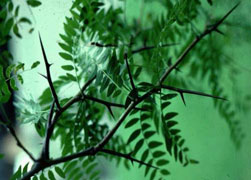


Home
Flowers &
Indoor Plants
Fruits & Nuts
Ornamentals
Vegetables
Special Topics
Resources
Glossary

Honey Locust |
 |
What about it? The honeylocust is a deciduous tree with alternating buds and branches. It will grow 50 to 60 feet tall. The branches are decorated by large thorns. Ile leaves are 6-10 inches long and are made up of 25-20 leaflets. In the fall the honeylocust tree produces pods that look like twisted beans. This indicates that the honeylocust tree is a legume, a plant in the bean family that produces nitrogen. The leaflets turn yellow in autumn and the pods turn a dark brown. Popular cultivars of honeylocust such as 'Shademaster' are both podless and thornless. What is it used for? Honeylocusts are not very dense but have an upright, spreading shape and therefore make a great shade tree. They also can be trimmed as large hedges. Where does it grow? How do we grow it? Honeylocusts tolerate most soils and are very winter hardy. Plant 50 feet apart. What are Its primary problems? The thorns on the honeylocusts are very large and can pose a potential hazard. There are now many thornless cultivars available. The tree produces many pods and can be viewed as a maintenance problem. The leaflets are very small and do not pose a maintenance problem. However, they are late to leaf in the spring. Honeylocusts are also susceptible to mites, pod gall midge, plant bugs, and mimosa webworm. The pod gall midge is an interesting critter though. Look closely for gall which are individual leaves. The galls formed by the insect are actually the homes or the cradles of the newly hatched midges.
© Copyright, Department of Horticulture, Cornell University. |



